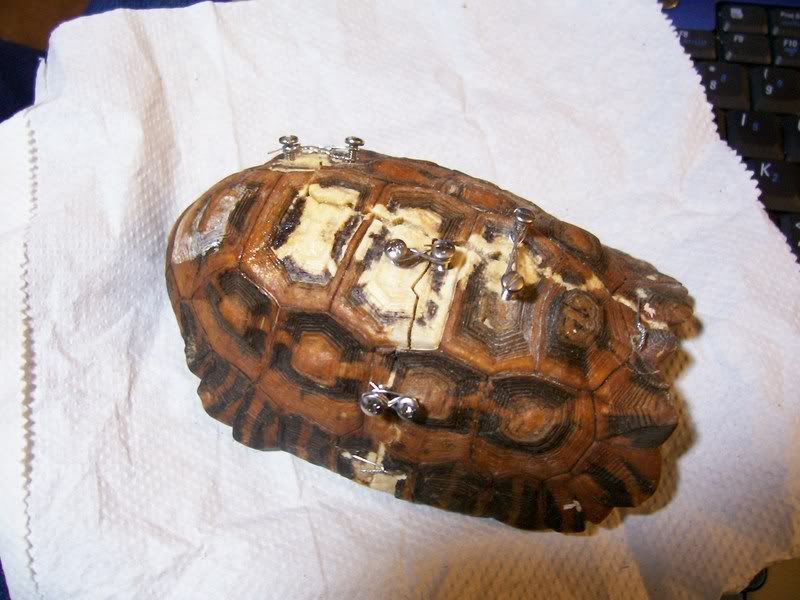Shell damageTortoise shells are both very tough, and
are
designed to get hurt by predators- absorbing all the abuse the body
would otherwise have to deal with. Many shell injuries can be treated
at home but you should see a vet or an expert if...
- the shell is cracked
through,
- there are pieces missing,
- there are holes into the body
cavity, or
- there is any sign of air movement in a crack or hole, or breathing is affected
Treatment
of minor shell damage-
- Carefully clean the area,
gently removing loose
parts (but do not force them).
- Swab the damaged
area with
Betadine
Solution and let dry.
- Apply a triple
antibiotic
ointment to any raw
areas.
- You can apply a sterile gauze
pad to the wound and use paper
tape to protect the shell, then use electrical tape on top of the paper
tape for strength and protection.
- If
the damage leaves a very sharp edge,
you can gently file it down like you would a fingernail.
- Give
the tortoise plenty of warmth and quiet to help it recover after. (See the ‘Nursing Care’ section.)
Damaged shell repaired by veterinarian
Skeletal injuries
Includes
fractures,
strains, dislocations. If the limb is misshapen or
swollen, or if the bone is showing, treat for shock and transport. Most
skeletal injuries should be seen by a vet, but if you want to do it
yourself…
- If the injury is bleeding, treat the wound first.
- If
you
need to splint the injury, use a tongue depressor, sheet metal,
etc. Make it the right size, pad sharp edges and pad the part that goes
against the limb.
- Carefully tape the splint in place. Immobilize
the bones or joints above and below, or vice versa.
- If
the limb is retracted, but looks to be in a natural position, just tape
it to keep it from moving. If it is not in a natural position, treat
for shock and transport.
- Treat for shock.
Beak and claw or nail problems
Overgrown
beaks and claws are often the result of poor husbandry and/or diet.
Some rough surfaces in the habitat, tough to bite foods, and the right
amounts of vitamin D and calcium help manage the beak and claws
normally.
Treatment–
Trimming the
overgrowth. Claws can be clipped like a small
dog’s claws- being sure to avoid the ‘quick’. (Note- do not trim the
foreclaws of slider-type turtles! They are meant to be long for
foreplay.)
Trimming minor beak overgrowth can sometimes be done
by increasing fiber, tougher stems and stalks, offering cuttlebones, and/or offering the food
on
a rougher surface.
If it is more overgrown, it is more difficult
and should be left to someone with experience.It is generally done with
a small file or a hand-held motor tool (Dremel) and a bit appropriate to
the animal’s
size and the severity of the overgrowth. The key points are being
gentle, taking a little off at a time, and trying to identify why it
happens to avoid future trims.
Resources
Edited 8-15-2012 (C) Mark Adkins
|
